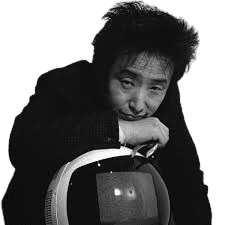Life and achievements
Early life
Nam June Paik was born in 1932 in Seoul, Korea, when the nation was still under the rule of Japan. His family was well-off, and he received classical music training during childhood, which prepared him for a career. Paik was born into a Korean family and grew up in Japan and the United States, which allowed him to receive an education in Western culture, later defining his works in modern technologies and art.
Paik and his family migrated to Japan during the Korean War and graduated from the University of Tokyo with a degree in aesthetics. His thesis on composer Arnold Schoenberg showed he was already interested in avant-garde music, which would be his artistic direction later. In 1957, Paik left for West Germany to study music history, and it was in this country, he came across Karlheinz Stockhausen and John Cage, two artists whose work he would embrace later on.
Paik's period in Europe was crucial as he engaged himself with the Fluxus, an avant-garde art movement that focused on performance, anti-art, and the employment of mundane objects. Here, Paik's interest in video and technology started to develop, which would later be used in his art.
Legacy
Nam June Paik's contribution is that of an innovator who changed the potential of video and electronic media into art. He foresaw a time when technology and art could come together, and his works are still relevant to artists who work with media today. Paik's impact is seen in incorporating video installations in galleries and museums, which he played a significant role in legitimizing as fine art.
Interestingly, Paik already envisioned the electronic superhighway, which is now the digital world and the internet, which can spread information and art worldwide. His work also predicted the concept of media democratization, where people can create and disseminate content globally, which is now evident with social media platforms.
It is also pertinent that Paik's work continues to be relevant today because most of the issues he dealt with, such as technology, media, and connectivity, are still topical today. His exhibitions still attract public attention, and his works have been presented at leading museums worldwide. Nam June Paik extended the possibilities of art by using television, video, and technology and influenced the contemporary visual culture.
Milestone moments
May 25, 1965
The first use of Sony Portapak
Nam June Paik was the first artist to use the Sony Portapak portable video recorder in 1965.
This was important because it enabled Paik to escape the studio and produce video art in real-life situations.
Paik documented Pope Paul VI's visit to New York City, which started his experimentation with video technology.
This portable device made video art a medium that could be easily manipulated, recorded, and transported from one place to another.
Paik's use of the Portapak was the first step towards the acceptance of video as an art, and it also identified Paik as the pioneer in media art.
Jan 1, 1984
Good Morning, Mr. Orwell
On New Year's Day in 1984, Paik telecasted a live satellite event called Good Morning, Mr. Orwell, connecting New York, Paris, and Seoul.
This performance was a clear message rejecting George Orwell's 1984 vision of the world by symbolizing the strength of art and the world's togetherness.
John Cage, Laurie Anderson, and Merce Cunningham were some artists who participated in the broadcast, which combined art, music, and technology.
This event showed Paik's idea of the "electronic superhighway" of media and telecommunications, bringing people worldwide together.
Good Morning, Mr. Orwell was one of Paik's most famous shows and proved that video art can transcend geographical barriers.
Jun 25, 1988
The More, The Better
Paik conceived The More, The Better for the 1988 Seoul Olympics, one of his most significant and complex works.
This was a monumental sculpture made of 1003 video monitors arranged in a cylindrical shape in which the monitors displayed various video images.
The work was intended to express Korean culture and the country's advancement during the international Olympic event.
The number 1,003 was chosen to reflect the myth of Korea's foundation and the unity of its citizens.
This installation was one of Paik's most famous and characteristic works, testimony to his talent for incorporating art and technology on such a large scale.
Sep 25, 1993
Electronic Superhighway: Continental U.S., Alaska, Hawaii
Paik created the installation Electronic Superhighway in 1993, covering Continental U.S., Alaska, and Hawaii, an immense map of the United States of America made from neon lights and video screens.
The work included video footage of the particular state and different cultural representations of America.
Paik's piece manifested his "electronic superhighway," depicting the increasing convergence of media and communication.
It was a milestone of media art, which established Paik's position as the pioneer of video installations.
This piece, still permanently in the Smithsonian American Art Museum, represents Paik's futuristic view of the digital age.
